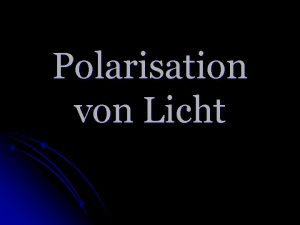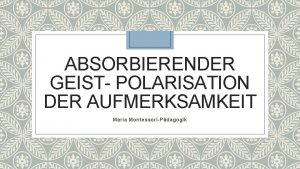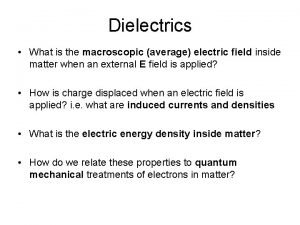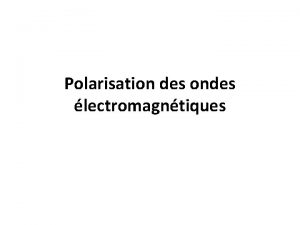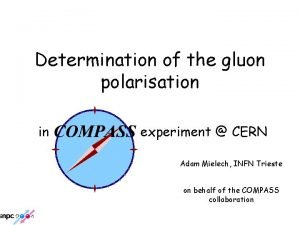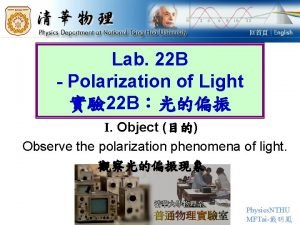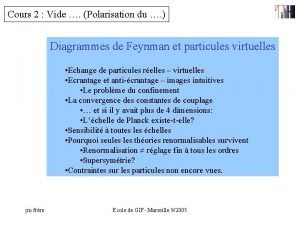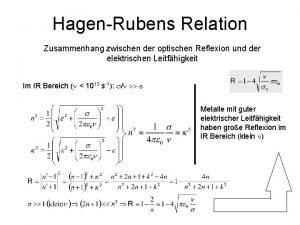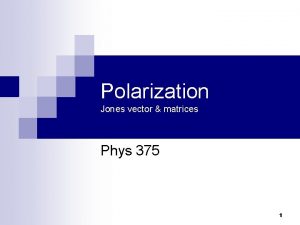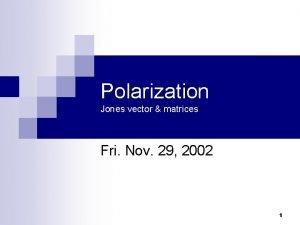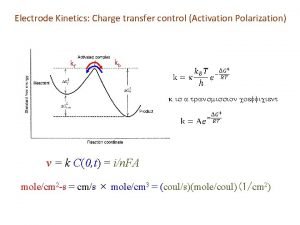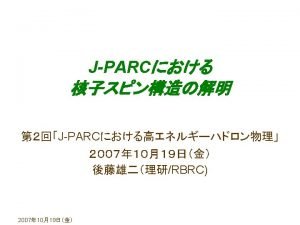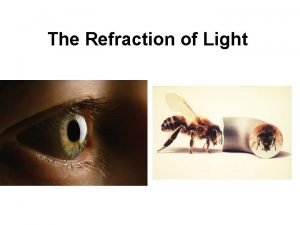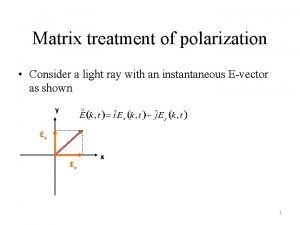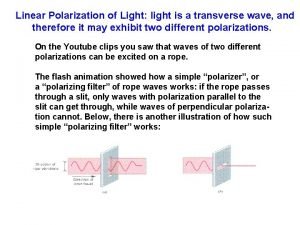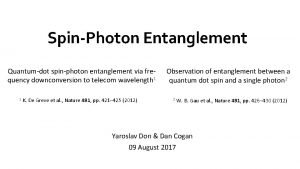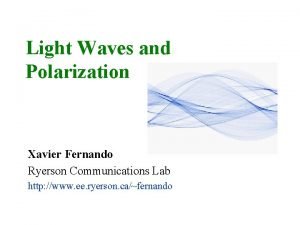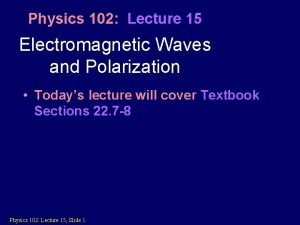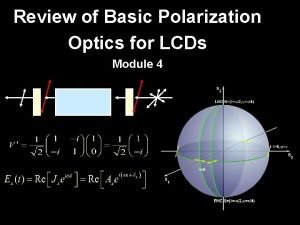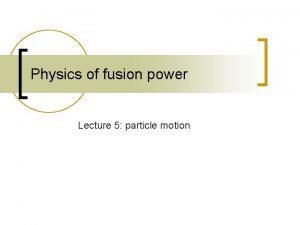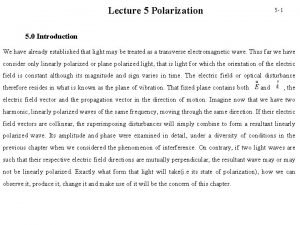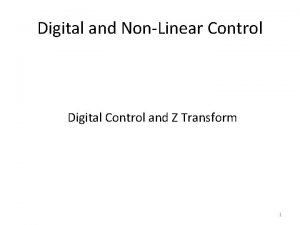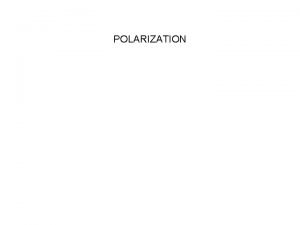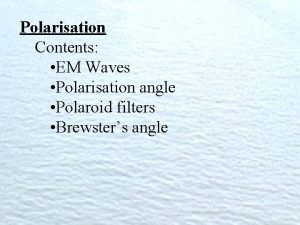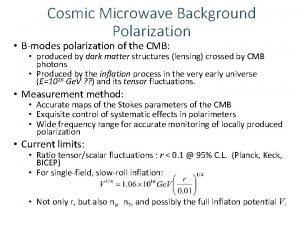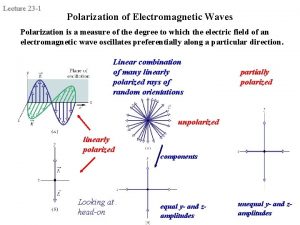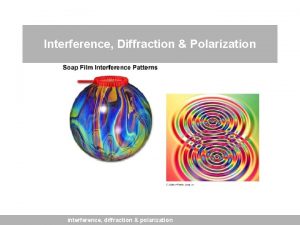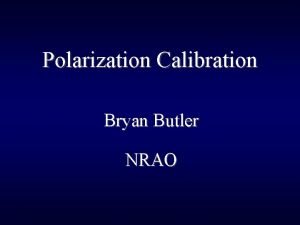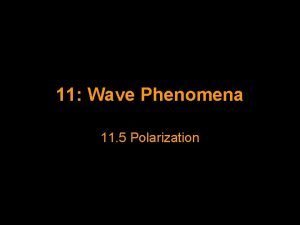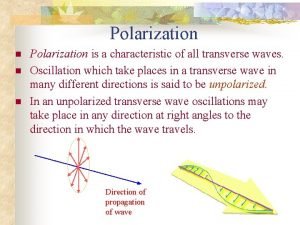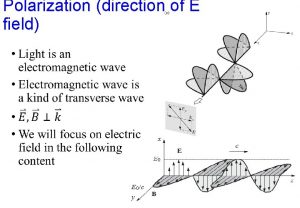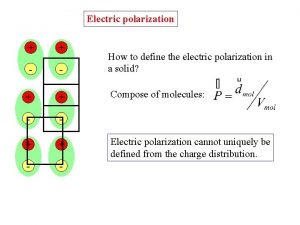Polarization 1 Polarisation XY Plane Plane of polarisation


























































- Slides: 58

Polarization 1

Polarisation XY – Plane: Plane of polarisation

S =(E x B)/μo

Radiation pattern http: //ocw. mit. edu/ans 7870/8/8. 02 T/f 04/visualizations/light/01 -Dipole. Radiation/01 -Dipole_320. html

Radiation intensity –Polar Plot The angular distribution of the intensity of radiation and its polarization state are shown θ I(θ)

Unpolarized light Polaroid: Transmits along the pass axis and absorbs along the perpendicular axis

Malus law

Unpolarized light

Degree of polarisation If the incident light is a mixture of unpolarised light of intensity Iu and polarised light of intensity Ip, then the transmitted light is given by:

Polarisation by scattering

Rayleigh scattering Blue sky Red Sunset / Sunrise

Convention

- Polarisation Plane of polarisation is same as plane of incidence - Polarisation Plane of polarisation is perpendicular to the plane of incidence

Polarisation by reflection

Brewster angle unpolarised linearly polarised partially polarised Glass

Brewster angle

Brewster’s law = Brewster angle

Polarisation by reflection

Polarisation by double refraction - Two refracted beams emerge instead of one - Two images instead of one Optic Axis: Uniaxial crystals exhibit cylindrical symmetry. There is a unique direction in a uniaxial crystal called the optic axis. Values of physical parameters along optic axis are different from the values perpendicular to it. Calcite Quartz

Ordinary ray Principal Plane: Extraordinary ray Optic axis Plane contains optic axis and the direction of propagation Calcite

Ordinary ray σ - polarised Calcite Polariser/ Analyser

Extraordinary ray π - polarised Calcite

Polarisation by double refraction Isotropic Medium : Velocity Spherical Anisotropic Medium : Velocity ellipsoid Uniaxial and Biaxial Crystals Uniaxial : Calcite, Quartz Biaxial: Mica

- Polarisation Plane of polarisation is same as plane of incidence (principal plane) This definition is considered in absence of Principal Plane - Polarisation Plane of polarisation is perpendicular to the plane of incidence (principal plane) Plane of incidence : plane contains incident ray, reflected/refracted ray, surface normal Plane of polarisation : plane contains electric field vector and direction of propagation Principal plane : Plane contains optic axis and the direction of propagation

e-ray : Plane of polarisation is same as principal plane e-ray in general does not obey the laws of refraction except in case of special cut of crystal (optic axis) o-ray Plane : of polarisation is perpendicular to the principal plane o-ray always obeys the laws of refraction Always e-ray carries -polarisation and o-ray carries -polarisation

Linear polarisation by double refraction Positive and Negative uniaxial crystals Quartz - no = 1. 5443 Positive ne = 1. 5534 For sodium D lines (ne - no)>0 ne > n o ve < vo Calcite - Negative (ne - no)<0 ne < n o no = 1. 6584 ne = 1. 4864 v > v e o Velocity or Refractive index is the same along the OPTIC AXIS for o-ray and e-ray.

Wave surface is the locus of all points reached by the ray at a given instant Velocity ellipsoid Positive crystal Quartz Sphere Spheroid ne > n o ve < vo

Positive crystal Quartz ne > n o Sphere ve < vo Spheroid

Positive crystal Quartz ne > n o Sphere ve < vo Spheroid

Calcite Negative crystal ne < n o ve > vo Spheroid Sphere

Calcite Negative crystal ne < n o ve > vo Spheroid Sphere

Calcite Negative crystal ne < n o ve > vo Spheroid Sphere

Biaxial

Huygens’ construction

Calcite ne < n o ve > vo

Special cuts of uniaxial crystal Optic axis normal to the surface of incidence No double refraction

Optic axis parallel to the surface of incidence No double refraction

Oblique Incidence Optic axis parallel to the surface of incidence, normal to the plane of incidence

Nicol prism Calcite no = 1. 6584 ne = 1. 4864 Canada balsam n = 1. 55

Rochon prism


Wollaston prism

Elliptical and circular polarisation Plane polarised Etc. Circularly polarised

Production of elliptically polarised light E A O O= E=

Retarders Quarter wave, Half wave and Full wave

GLASS

Quartz

Half wave plate Quartz

Babinet Compensator is a Variable retarder C . . . .

Interference of polarised light Fresnel-Arago laws 1. Two coherent rays polarised at right angles do not interfere 2. Two parallel coherent polarised rays will interfere in the same way as will ordinary light

Optically active medium Rotation of the plane of vibration & Rotatary dispersion Dextrorotatary or right handed medium Levorotatary or left handed medium Specific rotation = 21. 72 Deg/mm for Sodium lines

Sugar, Glucose and Fructose Specific rotation Sugar (Sucrose or Cane sugar) Glucose-D ( Dextrose or Grape sugar) Fructose (Levulose or Fruit sugar) 66. 47 52. 7 o - 92 o o

Rotation in liquids Specific rotation is defined as the observed rotation of light of wavelength 589 nm (the d line of a sodium lamp) passing through 10 cm of a 1 g ml-1 solution of a sample. One can find out the density of substance in solution Specific rotation, [ρ] = 10 θ / ld θ = angle of rotation l = Length of the liquid column in cm d = density in gm/cm 3

Fresnel’s explanation of rotation


Induced Optical Effects Isotropic medium can be made optically anisotropic applying 1. Stress : Photoelastic Effect 2. Magnetic field : Faraday Effect 3. Electric field : Kerr effect

Faraday effect d B =Verdet cosntant 0. 00001 -0. 01 min /Gauss-cm

Kerr effect An isotropic medium becomes birefringent by an application of electric field. It behaves like an uniaxial crystal with optic axis in the direction of applied field. K = Kerr Constant
 Software-defined networking: a comprehensive survey
Software-defined networking: a comprehensive survey Polarisation duden
Polarisation duden Absorbierender geist montessori
Absorbierender geist montessori Macroscopic electric field in dielectric
Macroscopic electric field in dielectric Polarisation circulaire
Polarisation circulaire Polarisation
Polarisation Polarisation
Polarisation Polarisation by scattering
Polarisation by scattering Polarisation
Polarisation Theoreme de babinet
Theoreme de babinet Electrogravimetry and coulometry
Electrogravimetry and coulometry Polarisation
Polarisation Dampfmaschine leifi
Dampfmaschine leifi Polarization catastrophe in ferroelectrics
Polarization catastrophe in ferroelectrics Group polarization vs groupthink
Group polarization vs groupthink Jones vectors
Jones vectors Social inhibition
Social inhibition Jones vector elliptical polarization
Jones vector elliptical polarization Activation polarization
Activation polarization Group polarization vs groupthink
Group polarization vs groupthink Depolarization factor
Depolarization factor Group polarization example
Group polarization example In a curved optical fiber light
In a curved optical fiber light Motorized polarization controller
Motorized polarization controller Ap psychology unit 14
Ap psychology unit 14 Membrane separation
Membrane separation Group polarization example
Group polarization example Group polarization
Group polarization Jones vector elliptical polarization
Jones vector elliptical polarization What is polarization in electrochemistry
What is polarization in electrochemistry Polarization index table
Polarization index table Linear polarization
Linear polarization Depolarization vs polarization
Depolarization vs polarization Situational attribution
Situational attribution Photon polarization
Photon polarization Xavier fernando
Xavier fernando Deindividuation
Deindividuation Polarization ellipse equation
Polarization ellipse equation Polarization in physics
Polarization in physics Group polarization in mean girls
Group polarization in mean girls Social facilitation
Social facilitation Group polarization psychology definition
Group polarization psychology definition Interference diffraction and polarization
Interference diffraction and polarization Polarization ellipse equation
Polarization ellipse equation Charge polarization
Charge polarization Photon polarization
Photon polarization Group polarization
Group polarization Electric field equation
Electric field equation Light polarization equation
Light polarization equation Polarization in chemistry
Polarization in chemistry Altruisml
Altruisml Forwarding equivalence class (fec)
Forwarding equivalence class (fec) Digital control
Digital control 후크의 법칙
후크의 법칙 Properties of plane areas
Properties of plane areas Persamaan normal bidang rata
Persamaan normal bidang rata Pateys stylomandibular tunnel
Pateys stylomandibular tunnel Example of section view
Example of section view Tessellate plane
Tessellate plane

